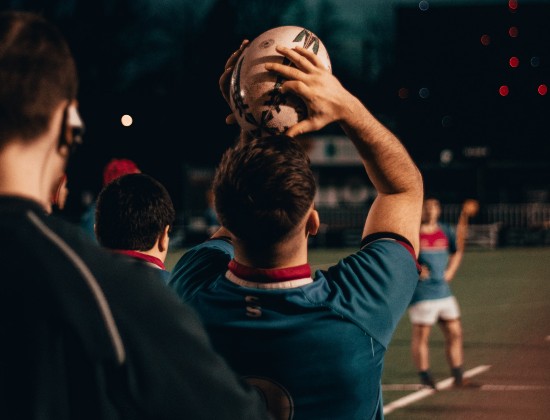The hooligan's game played by gentlemen: the top five rugby injuries
Fortius Clinic Consultant Chest Surgeon and rib expert Mr Ian Hunt and Acting RFU England Senior Men’s Rugby Team Doctor Dr Katy Hornby provide advice about common chest injuries.
Head injuries with concussions have rightly become a focus for those playing rugby and the many health professionals involved in the sport, along with shoulder, knee and ankle injuries. However, chest injuries – an injury anywhere between the neck and the abdomen – remain an important injury burden leading to damage to the chest wall (skin, fat and muscle), ribs, breastbone and any of the organs inside the chest.
Chest injuries can range from minor such as bruised ribs, to serious needing urgent medical attention.They are typically caused by a direct blow to the chest (blunt chest trauma). The level of contact in tackling, scrummaging and at the ruck make rugby one of the most physically demanding team sports. Here we list the five most common chest injuries seen amongst rugby players.
Chest wall bruising
Chest wall bruising is a common injury in rugby players. A direct blow to the chest or excessive and sudden twisting of the torso, especially against resistance, may result in ‘bruised ribs’. This causes localised pain and tenderness – often because of injury or strain to the skin, fat and soft tissues including the muscles overlying the rib cage and breastbone. The intercostal muscles can be strained or even torn – these are the muscles found between ribs and help breathing – and are often painful on breathing in and out. Muscle strains in the larger muscle groups, pectoralis major (pecs), are less common in rugby players but can happen during the action of tackling, or in training in the action of a bench press. The serratus anterior muscle spans the upper eight or nine ribs on the sides of the chest. It has an important function of moving the shoulder blade, activating classically in the motion of a boxer throwing a punch, throwing, passing, or handing off in a tackle. Injury results in chest wall pain at the sides and this is made worse when lifting your arms overhead.
Rib fractures
Rib fractures are typically caused by a direct force contact, although occasionally they can result from a more subtle action such as a violent twist against resistance. Rib fractures usually cause immediate pain and localised tenderness. It sometimes feels like a cracking feeling or there may even be an obvious lump. With the changes in rules around tackle height to protect the head area, increasingly tackles are targeting the midriff with ribs 7, 8 and 9 particularly vulnerable to injury. Fractures of the ribs can be single or multiple, non-displaced (hairline) or displaced. Depending on the type and number of rib fractures, recovery may be prolonged. Further investigations may be considered for diagnosis, occasionally to guide surgical treatment and for prognosis in terms of rehabilitation.
Cartilaginous rib fractures
Rugby-related cartilaginous rib fractures are an important group of chest wall injuries that can be challenging both to diagnose and to manage. The front part of the chest, between the breastbone (sternum) and ribs, is made up of a softer costal cartilage giving the chest flexibility to allow for one of the main functions of the chest – to aid breathing. Each ‘junction’ between rib, sternum, spine and costal cartilage, along with multiple ligamentous, tendinous and muscle attachments, make these ‘junctional’ areas susceptible to injury or prone to inflammation and damage. A sudden or violent torso rotation, or a direct blow to the lower chest wall, such as in tackling or in a ruck clear out, can lead to a costosternal or costochrondral injury with associated localised pain and tenderness. This may cause a lump and/or sensation of clicking or popping. These types of injuries are often described as a ‘popped rib’. Once suspected, clinically radiological investigations can be challenging as cartilage injuries can be difficult to pick up. If the lump or clicking persists injury may be related to a fracture dislocation of the junction and can lead to persistent pain and a permanent lump.
Sternal fractures
Less common, but occasionally related to a direct blow to the breastbone or sternum, a fracture typically relates to a significant impact at the gain line or when tackling head on. The player complains of pain which is sudden, sharp and intense and often made worse when breathing heavily. Most sternal fractures sustained during a match will be undisplaced but may still be associated with swelling, bruising and occasional ‘crepitus’ (crackling sensation under the skin). Often as the swelling settles the chest remains painful with certain activities and movements of the upper limbs especially pushing against resistance or when the arms are extended above the level of the shoulders. The diagnosis is based on suspicion of injury but typically involves a chest CT to assess the injury and to exclude other associated internal injuries including bruising of the lungs (contusion), cardiac contusion and even internal bleeding.
Internal chest injuries
The likelihood of internal injuries following a blow to the chest must always be considered, particularly if the player is complaining of breathing issues. One possible injury to the lung following a direct blow or related to a significant acceleration deceleration injury is a pneumothorax, or a collapsed lung. The mechanism of injury is a direct blow to one side of the chest leading to winding which when persists is associated with difficulty with breathing and pain when breathing in or out. If suspected, medical attention is needed with an examination for breath sounds (reduced if a pneumothorax) and a chest X-ray. If the player coughs up blood at pitch side or following a blow to the chest, they may have sustained an injury to the lung itself. A lung contusion can be significant and urgent medical attention is required. Although thankfully they are rare, both injuries can occur following rugby contact and should be considered


